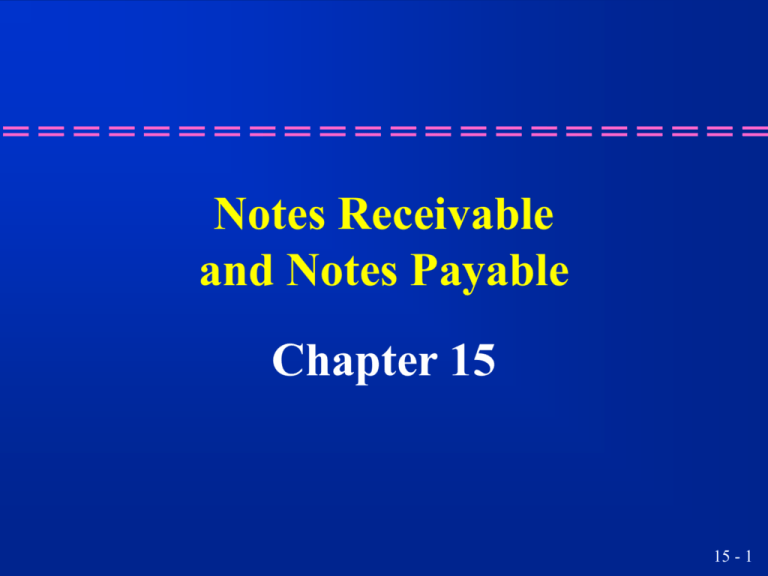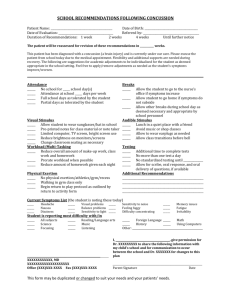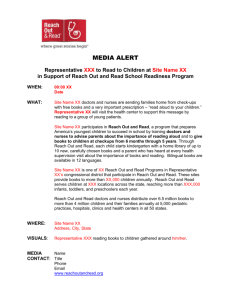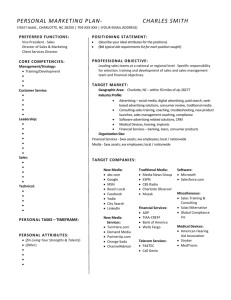Notes Receivable and Notes Payable
advertisement

Notes Receivable and Notes Payable Chapter 15 15 - 1 Learning Objective 1 Determining interest calculations and maturity dates on notes. 15 - 2 Learning Unit 15-1 What are promissory notes? They are a written promise to pay a certain sum of money to a lender at a fixed future date. The payee is the lender. The maker is the borrower. 15 - 3 Learning Unit 15-1 $20,000.00 Oct. 2, 20xx We, Green Company, promise to pay NATIONAL BANK TWENTY-THOUSAND AND 00/100…DOLLARS ON DECEMBER 1, 200x Date of issue Plus interest at the annual rate of 12 percent. __________ Principal Payee Maker 15 - 4 Learning Unit 15-1 Principal is the amount borrowed. Maturity date is the date the money is to be repaid. The interest rate is the yearly interest rate. The interest is adjusted to the length of time for short term notes. The obligation is called a note payable. 15 - 5 Learning Unit 15-1 Interest = Principal × Rate × Time What is the interest on the note due to National Bank? Principal: $20,000 Interest: 12% Time: October 2, 200x to December 1, 200x $20,000 × 12% × 60 ÷ 360 = $400 15 - 6 Learning Unit 15-1 Determining maturity date: The exact number of days in each month must be used. The date the note was issued is omitted. Add the days remaining until the total time on the note is reached. 15 - 7 Learning Objective 2 Journalizing entries to record renewal of a note, dishonoring of a note, eventual receipt of payment, and note given in exchange for equipment purchased. 15 - 8 Learning Unit 15-2 What is the entry to record a note receivable? Notes Receivable Sales xxx Notes Receivable Accounts Receivable xxx xxx xxx 15 - 9 Learning Unit 15-2 What is the entry to record payments? Cash xxx Notes Receivable Interest Income xxx xxx Notes Payable Interest Expense Cash xxx xxx xxx 15 - 10 Learning Unit 15-2 What is the entry to record a dishonored note? Accounts Receivable Interest Income Notes Receivable xxx Notes Payable xxx Interest Expense xxx Accounts Payable xxx xxx xxx 15 - 11 Learning Objective 3 Discounting an interest-bearing note receivable and recording a discounted note that has been dishonored. 15 - 12 Learning Unit 15-3 Sometimes notes are exchanged for cash at the bank (discounting). The number of days (up to maturity) that the bank will hold the note is called the discount period. Maturity value becomes the new principal (of the note) used to compute bank interest to be charged on the note. 15 - 13 Learning Unit 15-3 Bank discount is the amount of interest the bank will charge on the note. Cash proceeds is the amount of cash that will be received. Interest is deducted on the day the note is discounted and the money borrowed. That means the business uses less cash. 15 - 14 Learning Unit 15-3 The bank will receive the exact maturity value at due date. No interest is computed at that time. What are the steps? Compute maturity value: Interest = Principal × Rate × Time Principal + Interest = Maturity Value 15 - 15 Learning Unit 15-3 Calculate discount period: Number of days bank holds the note Bank discount = Maturity value × Bank discount rate (interest rate) × No. days bank holds note ÷ by 360. 15 - 16 Learning Unit 15-3 Cash Proceeds = Maturity Value – Bank Discount 15 - 17 Learning Unit 15-3 Cash Notes Receivable Interest Income xxx Cash Interest Expense Notes Receivable xxx xxx xxx xxx xxx 15 - 18 Learning Unit 15-3 The bank usually requires that a note be discounted with recourse. This means that if a note maker does not pay the maturity value to the bank, the company will have to pay the bank. This is called a contingent liability. 15 - 19 Learning Unit 15-3 If a note is dishonored, it is charged back to the customer using maturity value plus penalties as the new principal amount. 15 - 20 Learning Objective 4 Handling adjustments for interest expense and interest income. 15 - 21 Learning Unit 15-4 What does it mean to discount one’s own note payable? This means the interest is deducted from the amount borrowed. The cash proceeds to be used will be less than the principal amount. 15 - 22 Learning Unit 15-4 At maturity, the amount that has to be repaid is the exact face value of the note. The discount is a contra-account that is written off to interest expense over the life of the note. 15 - 23 Learning Unit 15-4 Interest expense and interest income will be computed up to the last day of the accounting period. An adjusting entry will be made to recognize interest expense as a debit and accounts payable as a credit. An adjusting entry will be made to recognize interest earned as a credit and interest receivable as a debit. 15 - 24 End of Chapter 15 15 - 25






